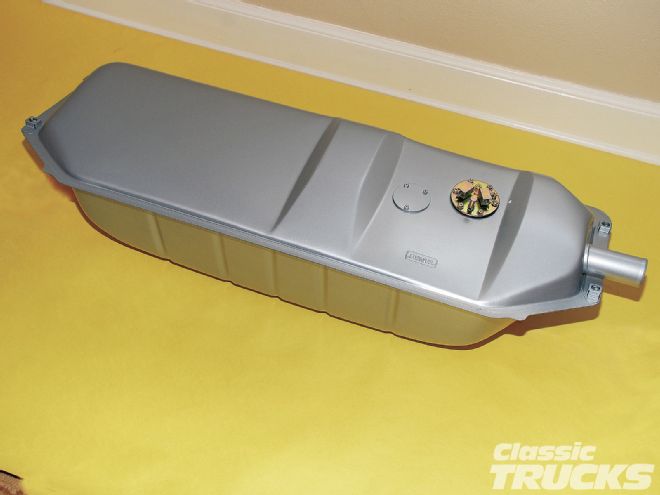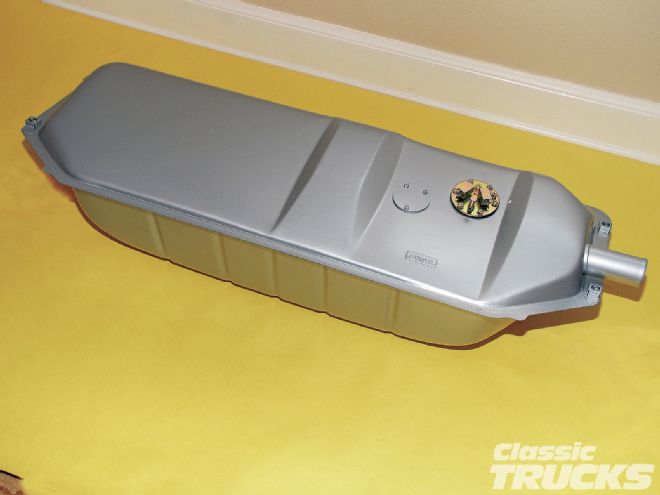
We’ve all been there, thinking maybe it is time to freshen up the old steed, bring it back to its former glory. You know, just a quick repaint, maybe fix a couple of those problems you’ve been putting up with over the years. That was the plan for my ’40 Ford, but it quickly turned into the “one thing leads to another” syndrome, and what was originally going to be a quick repaint became a color change, bed-off, motor-out repair process. I purchased this truck about four years ago, the original builder is unknown. It was a reasonably well-built truck that appeared to have been completed in the ’80s. However, time has a way of wearing things out and, frankly, we are better at building trucks today.
 With an eye to the future we decided to install a new Tanks gas tank in our ’40 pickup. We also bought the in-tank fuel pump for carburetor pressure, but if we want to convert to EFI in the future we can simply swap out the pump for a high-pressure EFI pump with a return line.
With an eye to the future we decided to install a new Tanks gas tank in our ’40 pickup. We also bought the in-tank fuel pump for carburetor pressure, but if we want to convert to EFI in the future we can simply swap out the pump for a high-pressure EFI pump with a return line.
An initial examination of the fuel system showed room for improvement and a rather alarming fuel line. The tank was the original 1940 tank, and while it was in good condition it also had a tiny outlet line designed to feed a flathead. Problem is, it’s feeding a 327 installed by the original builder using some very stout, homebrewed motor mounts. Unfortunately, these mounts eliminated the stock fuel pump so it relied on an external electric fuel pump. This system served us well, and since we had mounted our external pump below the fuel level in the tank it worked fine. Remember, electric fuel pumps are pushers so they must be mounted with a gravity flow of fuel to the inlet side.
The aforementioned fuel line was an odd combination of aluminum tubing with sections of rubber hose connecting them in no less than three places, one of which was hidden behind a boxed section of the frame. I immediately decided to run a whole new fuel line, in steel, from the tank to the firewall, and it was right about this time that I began to look to the future. Most of us will agree the future of fuel delivery is electronic fuel injection. While I was not quite ready to convert to EFI right now, I wanted to have a fuel delivery system that could be easily adapted to the high-pressure, higher-volume pumps used for EFI.
And that’s when I decided the best route would be to install a new gas tank from Tanks. While our example is a ’40 Ford unit, bear in mind Tanks has a full line of fuel tanks for virtually all popular applications.
The new tank would provide us with a three-fold improvement. First, a brand-new tank with expanded capacity; second, a large fuel outlet and in-tank submersible fuel pump that is far superior to most external electric pumps; and finally, a vented tank that would eliminate the need to run a vented gas cap. It was clear the Tanks gas tank would be the perfect solution to our fuel delivery problems now and into the future. Should I decide to convert to EFI it will be a simple matter of swapping in a high-pressure in-tank pump, running a return line, and then making the connection to the induction system.
The installation itself was quite simple, particularly since the bed was off the truck. The new Tanks gas tank bolted right in place and while the bottom of the tank is about an inch lower it still leaves ample room for tailpipes, plus it extends our cruising range. A pad between the tank and the frame prevents any metal-to-metal contact, and the tank lined up perfectly with the factory holes in the frame.
After the tank was positioned we routed the new fuel line along the top of the tank and into the side framerail, keeping it safely away from things like the exhaust system. We opted for basic steel lines with inverted flare fittings found at our local parts store. Stainless steel would no doubt be a better choice, but in the interest of budget and availability we went with steel tubing.
The in-tank fuel pump, also purchased from Tanks, was designed for carburetors with a maximum output of 8 psi, but they still advised us to use a pressure regulator. And while our tank and fuel lines are brand new they also recommend the use of a fuel filter, because dirt can be transferred while refueling.
A tubing bender was used for all bends, making for a professional looking job and preventing any unwanted kinks in the line. The line was attached to the chassis with Adel clips and routed up the firewall to a large Fram fuel filter and Holley pressure regulator. A Moon fuel pressure gauge purchased from Honest Charley Speed Shop monitors the fuel pressure and adds all-important style points to the firewall. The final connection from the firewall and hard tubing to the motor must incorporate a flexible line. There are several choices here, ranging from the basic neoprene gas line in black to a higher-quality braided stainless steel line with AN fittings. We opted for basic rubber hose as we are going for a ’60’s vintage appearance under the hood. Finally, we set the pressure at 3 psi to feed our trio of Rochester carburetors, and our all-new system was complete. CT